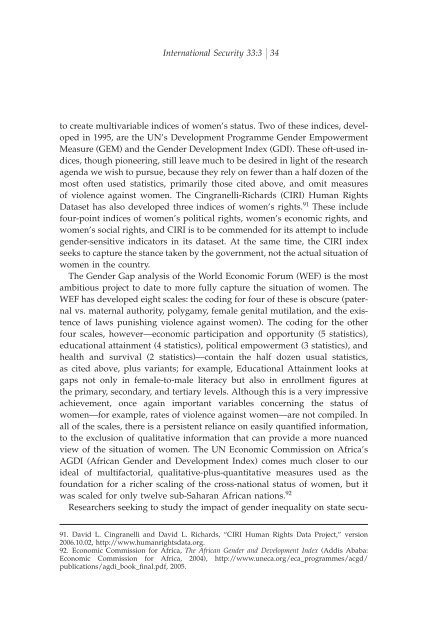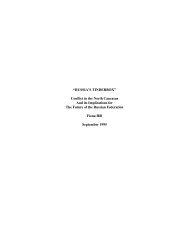The Heart of the Matter Valerie M. Hudson, - MIT Press Journals
The Heart of the Matter Valerie M. Hudson, - MIT Press Journals
The Heart of the Matter Valerie M. Hudson, - MIT Press Journals
Create successful ePaper yourself
Turn your PDF publications into a flip-book with our unique Google optimized e-Paper software.
International Security 33:3 34<br />
to create multivariable indices <strong>of</strong> women’s status. Two <strong>of</strong> <strong>the</strong>se indices, developed<br />
in 1995, are <strong>the</strong> UN’s Development Programme Gender Empowerment<br />
Measure (GEM) and <strong>the</strong> Gender Development Index (GDI). <strong>The</strong>se <strong>of</strong>t-used indices,<br />
though pioneering, still leave much to be desired in light <strong>of</strong> <strong>the</strong> research<br />
agenda we wish to pursue, because <strong>the</strong>y rely on fewer than a half dozen <strong>of</strong> <strong>the</strong><br />
most <strong>of</strong>ten used statistics, primarily those cited above, and omit measures<br />
<strong>of</strong> violence against women. <strong>The</strong> Cingranelli-Richards (CIRI) Human Rights<br />
Dataset has also developed three indices <strong>of</strong> women’s rights. 91 <strong>The</strong>se include<br />
four-point indices <strong>of</strong> women’s political rights, women’s economic rights, and<br />
women’s social rights, and CIRI is to be commended for its attempt to include<br />
gender-sensitive indicators in its dataset. At <strong>the</strong> same time, <strong>the</strong> CIRI index<br />
seeks to capture <strong>the</strong> stance taken by <strong>the</strong> government, not <strong>the</strong> actual situation <strong>of</strong><br />
women in <strong>the</strong> country.<br />
<strong>The</strong> Gender Gap analysis <strong>of</strong> <strong>the</strong> World Economic Forum (WEF) is <strong>the</strong> most<br />
ambitious project to date to more fully capture <strong>the</strong> situation <strong>of</strong> women. <strong>The</strong><br />
WEF has developed eight scales: <strong>the</strong> coding for four <strong>of</strong> <strong>the</strong>se is obscure (paternal<br />
vs. maternal authority, polygamy, female genital mutilation, and <strong>the</strong> existence<br />
<strong>of</strong> laws punishing violence against women). <strong>The</strong> coding for <strong>the</strong> o<strong>the</strong>r<br />
four scales, however—economic participation and opportunity (5 statistics),<br />
educational attainment (4 statistics), political empowerment (3 statistics), and<br />
health and survival (2 statistics)—contain <strong>the</strong> half dozen usual statistics,<br />
as cited above, plus variants; for example, Educational Attainment looks at<br />
gaps not only in female-to-male literacy but also in enrollment ªgures at<br />
<strong>the</strong> primary, secondary, and tertiary levels. Although this is a very impressive<br />
achievement, once again important variables concerning <strong>the</strong> status <strong>of</strong><br />
women—for example, rates <strong>of</strong> violence against women—are not compiled. In<br />
all <strong>of</strong> <strong>the</strong> scales, <strong>the</strong>re is a persistent reliance on easily quantiªed information,<br />
to <strong>the</strong> exclusion <strong>of</strong> qualitative information that can provide a more nuanced<br />
view <strong>of</strong> <strong>the</strong> situation <strong>of</strong> women. <strong>The</strong> UN Economic Commission on Africa’s<br />
AGDI (African Gender and Development Index) comes much closer to our<br />
ideal <strong>of</strong> multifactorial, qualitative-plus-quantitative measures used as <strong>the</strong><br />
foundation for a richer scaling <strong>of</strong> <strong>the</strong> cross-national status <strong>of</strong> women, but it<br />
was scaled for only twelve sub-Saharan African nations. 92<br />
Researchers seeking to study <strong>the</strong> impact <strong>of</strong> gender inequality on state secu-<br />
91. David L. Cingranelli and David L. Richards, “CIRI Human Rights Data Project,” version<br />
2006.10.02, http://www.humanrightsdata.org.<br />
92. Economic Commission for Africa, <strong>The</strong> African Gender and Development Index (Addis Ababa:<br />
Economic Commission for Africa, 2004), http://www.uneca.org/eca_programmes/acgd/<br />
publications/agdi_book_ªnal.pdf, 2005.
















